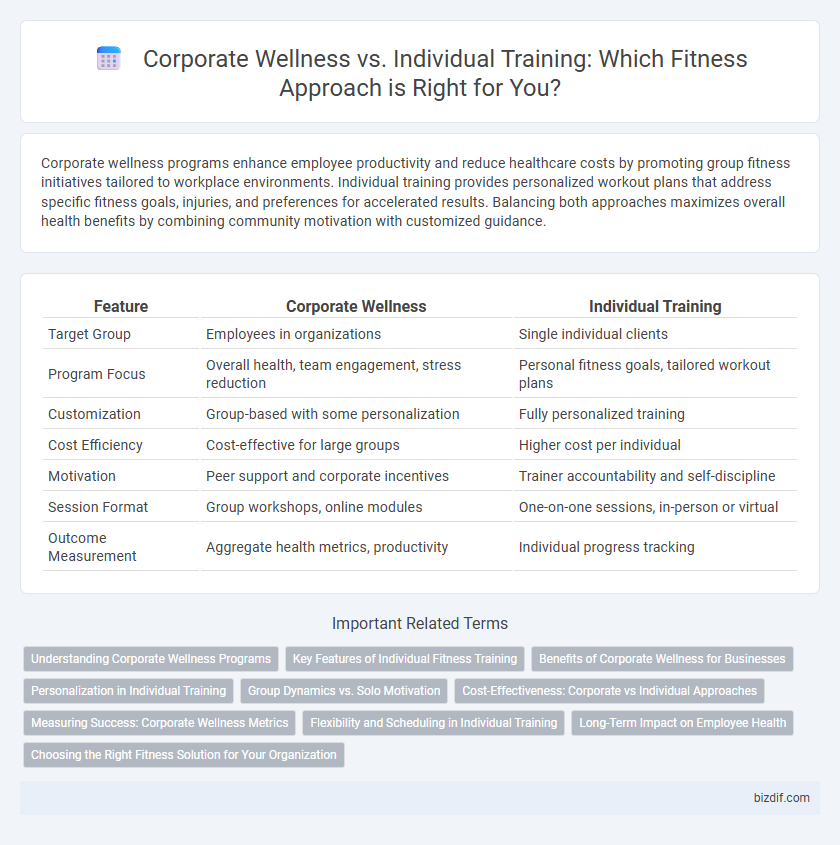Corporate wellness programs enhance employee productivity and reduce healthcare costs by promoting group fitness initiatives tailored to workplace environments. Individual training provides personalized workout plans that address specific fitness goals, injuries, and preferences for accelerated results. Balancing both approaches maximizes overall health benefits by combining community motivation with customized guidance.
Table of Comparison
| Feature | Corporate Wellness | Individual Training |
|---|---|---|
| Target Group | Employees in organizations | Single individual clients |
| Program Focus | Overall health, team engagement, stress reduction | Personal fitness goals, tailored workout plans |
| Customization | Group-based with some personalization | Fully personalized training |
| Cost Efficiency | Cost-effective for large groups | Higher cost per individual |
| Motivation | Peer support and corporate incentives | Trainer accountability and self-discipline |
| Session Format | Group workshops, online modules | One-on-one sessions, in-person or virtual |
| Outcome Measurement | Aggregate health metrics, productivity | Individual progress tracking |
Understanding Corporate Wellness Programs
Corporate wellness programs offer tailored fitness training designed to improve employee health, reduce absenteeism, and boost productivity by incorporating group workouts, health screenings, and wellness challenges. These programs foster a supportive environment for lifestyle changes, leveraging expert guidance and team motivation to achieve collective health goals. Compared to individual training, corporate wellness emphasizes scalable solutions that align with organizational culture and workforce needs, resulting in measurable returns on investment.
Key Features of Individual Fitness Training
Individual fitness training offers personalized workout plans tailored to specific goals, fitness levels, and health conditions, maximizing effectiveness and minimizing injury risk. One-on-one coaching ensures continuous motivation, real-time form correction, and adaptability to progress or setbacks. This approach enables precise tracking of performance metrics such as strength gains, endurance improvements, and body composition changes for optimal results.
Benefits of Corporate Wellness for Businesses
Corporate wellness programs enhance employee productivity by reducing sick days and healthcare costs through structured fitness initiatives. These programs foster team cohesion and improve workplace morale, leading to a more engaged and motivated workforce. Businesses benefit from a healthier employee base, which directly contributes to increased efficiency and reduced turnover rates.
Personalization in Individual Training
Individual training offers highly personalized fitness plans tailored to specific goals, fitness levels, and preferences, unlike corporate wellness programs that often provide generalized activities for broad employee groups. Customized workouts and one-on-one coaching optimize progress and address unique health concerns effectively. This personalization enhances motivation, adherence, and overall results in fitness training.
Group Dynamics vs. Solo Motivation
Corporate wellness programs leverage group dynamics to foster teamwork, accountability, and collective motivation, enhancing overall employee health and productivity. Individual training focuses on solo motivation, allowing for personalized goal-setting and flexible scheduling tailored to specific fitness needs. Group settings in corporate wellness often lead to higher engagement and sustained commitment compared to solitary workouts.
Cost-Effectiveness: Corporate vs Individual Approaches
Corporate wellness programs typically offer cost-effective fitness training by leveraging group rates and reducing per-person expenses through volume discounts, making them more affordable for organizations. Individual training, while tailored and personalized, often incurs higher costs due to one-on-one sessions and customized plans. Evaluating overall ROI, corporate wellness initiatives tend to deliver greater financial efficiency by improving employee health collectively and reducing absenteeism.
Measuring Success: Corporate Wellness Metrics
Corporate wellness programs measure success through employee participation rates, health risk assessments, and reductions in absenteeism and healthcare costs. Key metrics also include improvements in employee productivity, engagement levels, and biometric outcomes such as blood pressure and cholesterol. Tracking these data points enables organizations to quantify the impact of wellness initiatives on workforce health and overall business performance.
Flexibility and Scheduling in Individual Training
Individual training offers unparalleled flexibility and personalized scheduling tailored to each client's unique lifestyle and fitness goals. Clients can select session times that accommodate work commitments, family responsibilities, and personal preferences, enhancing adherence and consistency. Customized programming in individual training allows immediate adjustments to intensity and exercises, optimizing progress and minimizing injury risks.
Long-Term Impact on Employee Health
Corporate wellness programs foster sustained employee health by integrating fitness training into the work environment, leading to reduced absenteeism and enhanced productivity over time. Structured group activities and health education promote consistent exercise habits and stress management, creating a culture of well-being that benefits both the company and its workforce. Individual training offers personalized fitness plans but may lack the social and motivational support systems crucial for maintaining long-term health improvements in an organizational setting.
Choosing the Right Fitness Solution for Your Organization
Corporate wellness programs foster group engagement and improve overall employee health, reducing absenteeism and boosting productivity. Individual training offers personalized fitness plans tailored to specific goals and needs, promoting faster progress and injury prevention. Analyzing company size, budget, and employee preferences helps determine the optimal balance between corporate wellness initiatives and individualized training solutions.
Corporate Wellness vs Individual Training Infographic

 bizdif.com
bizdif.com